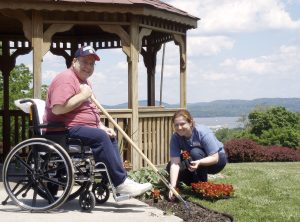How to Create an Accessible Home Garden
July 7, 2021
Gardening is great way to improve physical and mental health. If you are a person with a disability, there are many ways to reap the benefits of gardening by creating an environment that allows you to work in your garden safely, comfortably, and independently. We sat down with HHH Adapted Sports & Recreation Coordinator Peter Gagliardo to learn about ways to adapt a home garden, as well as different types of tools and equipment that can fit the needs of people of all abilities.
Ways to Adapt Your Garden
- Make sure that the location of your garden, such as walkways or patios, are well paved and offer good traction. For individuals in a wheelchair or walker, the path should be at least 40 inches wide for full mobility around the garden.
- Raised garden beds that have the soil level at 24”-36” from the ground work great for gardeners that can work from a seated position. Gardeners that will work from their wheelchair should have a raised planter at around 34” to allow room for their knees to fit comfortably under the bed.
- Another great option to try is vertical gardening. If you do not have wide enough pathways or the space to have raised garden beds installed, you can hang plants or flowers from fences or overhangs. This is especially helpful for individuals that may have difficulty getting low to the ground and individuals in a wheelchair can customize the proper height of the planters so they can work comfortably.
Adaptive Tools
- For individuals that can sit or kneel to work in their garden, a kneeling pad/outdoor stool will provide a comfortable and stable surface to work from. Try: https://www.arthritissupplies.com/yard-butler-garden-seat-kneeler.html
- Long reach tools can be very helpful for gardeners that are working from a seated position or while in a wheelchair. Try: https://www.arthritissupplies.com/peta-easi-grip-long-reach-garden-tools-set.html
- An arm support cuff can be added to most tools to help make the tools more comfortable to use and reduces strain on the wrist and fingers. Try: https://www.arthritissupplies.com/peta-easi-grip-arm-support-cuff.html
- Tools with a fist grip can keep the hand and wrist in a neutral position so individuals with conditions such as arthritis or carpal tunnel can enjoy gardening with less pain and stress on the tendons. Try: https://www.arthritissupplies.com/peta-easi-grip-garden-tools-set-of-3.html
For more information on how to make your garden more accessible or suggestions on adapted tools and techniques, please contact HHH Adapted Sports & Recreation Program Coordinator Peter Gagliardo at 845-786-4950 or peter.gagliardo@helenhayeshosp.org.
